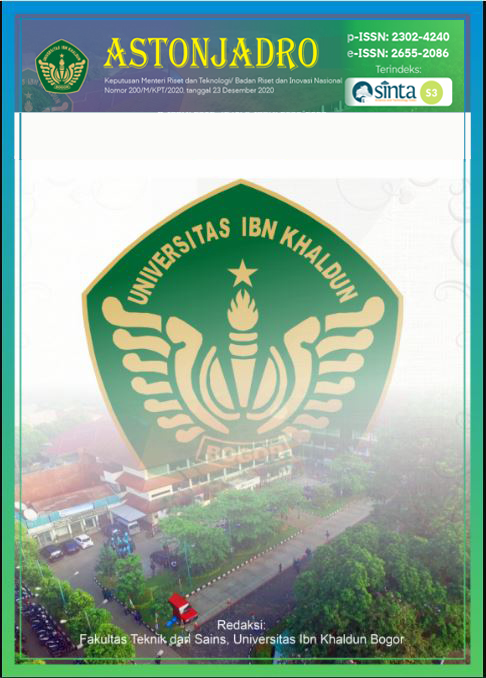The Impact of Relocating Illegal Settlement at Simpang Barelang, Batam City, Riau Islands
DOI:
https://doi.org/10.32832/astonjadro.v12i3.9340Keywords:
slum, relocation, community, impact, negative.Abstract
Slum settlements in Batam City are mostly inhabited by poor people who are unable to access proper housing. The inability of the poor to access these decent settlements, makes them choose to live in slum settlements with inadequate basic facilities and infrastructure. Relocation or resettlement is an alternative to provide opportunities for people living in slum settlements, whose land status is illegal or living in a disaster-prone environment to reorganize and continue their lives in a new place. This research was structured with the aim of knowing how the implementation of the relocation program for occupation settlements at the Simpang Barelang in the city of Batam. As a qualitative and quantitative descriptive research, the results of this study have both positive and negative impacts. In terms of physical conditions, relocation provides positive changes to the current settlement conditions. Then the social impact of the relocation carried out in the Tembesi Village, has also been successful in maintaining the social order that has been formed. However, in terms of the community's economy, the relocation program had a negative impact due to the loss of sources of income and decreased community income.
References
Adharani, Yulinda; Nurzaman, Adi. 2017. Fungsi Perizinan Dalam Pengendalian Pemanfaatan Ruang di Kawasan Bandung Utara Dalam Kerangka Pembangunan Berkelanjutan. Bandung: Universitas Padjadjaran.
Ahmad, Muhajir. 2017. Kebijakan Pengendalian Pemanfaatan Ruang Dalam Pelaksanaan Ketentuan Penataan Ruang di Kota Baubau Provinsi Sulawesi Tenggara. Jakarta: Institut Pemerintahan Dalam Negeri Jakarta.
Akil, Arifuddin; Arifin, Mimi. 2020. Penyuluhan Mekanisme Pengendalian Pemanfaatan Ruang Wilayah Kota di Kantor Kecamatan Biringkanaya Kota Makasar. Makasar: Universitas Hasanuddin.
Alfian, Legal sociology of agricultural functions in the former peatland project, Pulang Pisau Regency, Central Kalimantan». International Journal of Management (2020).
Haryadi dan Setiawan (2010). Arsitektur Lingkungan dan Perilaku: Suatu Pengantar ke Teori, Metodologi dan Aplikasi, Gadjah Mada University Press.
Komarudin, 1992, Ensiklopedia Manajemen. Jakarta : Bumi Aksara.
Moleong, 2015, Metodologi Penelitian Kuantitatif, Bandung: Remaja Rosdakarya.
Mutaali, Luthfi. 2012. Daya Dukung Lingkungan Untuk Perencanaan Pengembangan Wilayah. Yogyakarta: Badan Penerbit FGE UGM.
Ridho, Muhammad. (2001). Kemiskinan di Perkotaan. Semarang: Garuda Mas.
Snyder dan Catanese A., 1979. An Introduction to Urban Design, New York; Harper and Row.
Sulistiani, Siti Rukayah, Ratih Sari, 2018. Konservasi Nilai-nilai Kearifan Lokal pada Pola Tata Ruang ‘Huma Hai’ Djaga Bahen; Studi Kasus: Humahaidjagabahendidesabahupalawa, Kalimantan tengah. Semarang; Universitas Diponegoro.
Sujarto, D. 2005. Kota berkelanjutan. Bandung: P.T Alumni.
Undang-undang Republik Indonesia. Nomor 4 tahun 1992. Tentang. Perumahan dan Permukiman.
Ven, Cornelis Van De, 1995. Ruang Dalam Arsitektur. Jakarta; Gramedia Pustaka Utama.
Wardiningsih, S. 2015. Arsitektur Nusantara Mempengaruhi Bentuk Bangunan Yang berkembang di Indonesia. Jakarta; Institut Sains dan Teknologi Nasional.
Yudohusodo, Siswono, 1991, Rumah Untuk Seluruh Rakyat. Jakarta: INKOPPOL.
Annonymous. 2016. Kamus Besar Bahasa Indonesia. Jakarta: Balai Pustaka.
Downloads
Published
How to Cite
Issue
Section
License
Copyright (c) 2023 ASTONJADRO

This work is licensed under a Creative Commons Attribution-ShareAlike 4.0 International License.
Paper submitted to ASTONJADRO is the sole property of the Astonjadro Journal. Unless the author withdraws the paper because he does not want to be published in this journal. The publication rights are in the journal Astonjadro.ASTONJADRO
LICENSE
This work is licensed under a Creative Commons Attribution-ShareAlike 4.0 International License.
Based on a work at http://ejournal.uika-bogor.ac.id/index.php/ASTONJADRO













